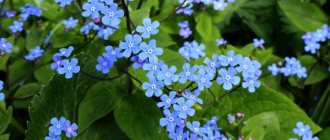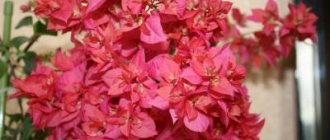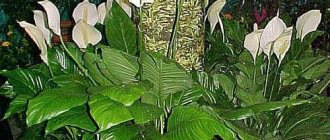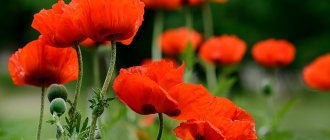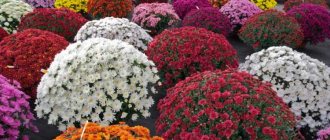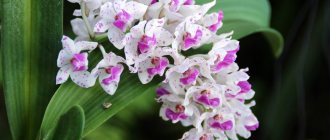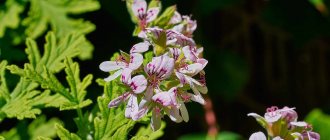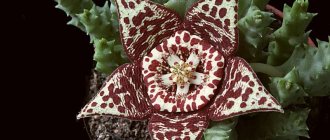Eucalyptus (Eucalyptus) is one of the fastest growing and largest trees in the world. The genus of culture includes more than 700 plant species, most of which come from Australia.
Currently, eucalyptus trees are widespread in Africa, Asia, South and North America.
Australian eucalyptus began to be grown as a houseplant relatively recently. According to NASA, the plant is one of the top 10 indoor plants that improve indoor air quality.
At home, the tree is completely undemanding and, unlike other crops, indoor eucalyptus is extremely resistant to pests.
Types and varieties of eucalyptus, appearance
Eucalyptus leaves are pointed, oblong, somewhat similar to the leaves of our willow. The oldest eucalyptus tree reaches 100 m in height. However, its height can vary; eucalyptus can also grow as a shrub. The eucalyptus flower is yellow, red or white and looks very interesting. They look like a bunch of fringe with small dots of a different color at the end. The tree crowns themselves usually have a weeping shape.
In total, more than 700 species of this plant are known. There are conical, almond-leaved, berry, crowded, ash, white, parvifolia and other types of eucalyptus.
Spreading
Eucalyptus trees are giant plants. Many of them reach the size of a skyscraper during their lives; the tallest tree in the world is considered to be in the forests of Tasmania: its height is 101 m - several times higher than that of many recognized giants. However, this is not the limit; biologists have unconfirmed verbal descriptions of giants 150 m high.
The homeland of most species - several hundred - is considered to be Australia and the nearby islands, where these myrtaceae make up almost 90% of all forests and groves. Some varieties are found in the tropics and subtropics of Southern France, Portugal, Greece, India, Southern China, Malaysia, Israel, Crimea and other regions with a warm and humid climate; they prefer well-lit areas. Eucalyptus trees grow on nutritious, slightly acidic or neutral soils, but many adapt to sandstones, podzolic soils and loams. They tolerate short-term flooding well.
Species found in mountainous areas are frost-resistant, but many are still afraid of cold weather and quickly die at sub-zero temperatures.
“Trees” over 50 m tall are far from uncommon among eucalyptus trees. Based on the appearance and structure of the bark, several types of trees are distinguished: smooth-barked, iron-barked, scaly-barked, fibrous-barked, and peppermint. During the process of growth, the bark of many of them falls off the trunks in pieces or whole layers, exposing deeper layers. In this property, eucalyptus is similar to sycamore, which also sheds sections of bark. The color of the surface of the bark of one tree can change over the years; the trunk often combines bright green, yellow, red and purple areas. A clear example of such multicoloredness is found in the rainbow eucalyptus, growing in the tropical Philippines and Indonesia.
Where and how does it grow
Eucalyptus (a tree native to Australia) grows in entire groves, or even creating forests. There this wild plant forms entire thickets. It also grows wild in large quantities in Indonesia, New Zealand, the Philippine Islands and New Guinea. Now it grows not only there, but in most corners of the earth.
Eucalyptus grows quickly, and this has gained popularity among green spaces not only in Asia and Africa, but also in Europe and America. It is often used to drain soil in wetlands. Eucalyptus trees prefer to grow in places where there is a lot of sunlight, particularly on mountain slopes. However, some of their species also grow in gorges.
Use of the plant in cooking
Eucalyptus is known not only for its medicinal properties, but also for its taste. The plant is used to prepare tonic energy drinks. The mixture of eucalyptus, honey and water is very reminiscent of the “vitamin bomb” made from ginger, honey and lemon, familiar from childhood. Both remedies strengthen the immune system, help the body fight infections, instantly tone up and put a sick person back on his feet. It is best to prepare such drinks in the cold season in order to further protect the body from all kinds of viruses.
Eucalyptus is a traditional element of the Asian culinary tradition. The plant organically “fits” into spicy soups, sweet meat marinades and specific national dishes. Ground eucalyptus is one of the most common spices. Asians use it as often as we use ground black pepper.
Almost every type of eucalyptus produces a burning juice of a rich red hue. Locals call this juice “Australian cinema” and use it for soups, spicy meat and fish dishes.
Application
In cooking
A small amount of eucalyptus leaves is added to marinades for meat and fish, which gives them an indescribable, lasting aroma. In addition, they are even added to confectionery products, which gives them a feeling of freshness. Eucalyptus is also added to tea if you want to get a boost of energy for the day or to keep warm in bad weather.
In medicine
Eucalyptus is very widely used in medicine due to its disinfectant, wound healing and analgesic properties, as well as its ability to strengthen the immune system. Its healing properties are used in the treatment of bronchitis, sore throat, acute respiratory infections, influenza and even tuberculosis. As well as osteochondrosis, arthritis, neuralgia and many other diseases.
When losing weight
Scientists have proven that inhaling eucalyptus essential oil reduces food cravings. So if you get excited by the sight of delicious food in a window or in a picture, eucalyptus oil will help you. And if you're just trying to lose weight, inhaling eucalyptus oil before meals will reduce your appetite, resulting in you being satisfied with a much smaller portion.
At home
The aroma of eucalyptus oil or freshly ground dry leaves of this plant helps get rid of unpleasant odors in the house. In addition, harmful insects, including mosquitoes, also do not like this smell. And for those who like to take a steam bath, a eucalyptus broom will bring double pleasure and benefit.
In cosmetology
Eucalyptus is used to care for problematic and oily facial skin, treat herpes or other acne due to its antibacterial properties. A decoction of eucalyptus leaves is frozen in portions and the skin prone to rashes is rubbed with this ice. Eucalyptus contains substances that promote skin cell regeneration. That is why it is added to many creams and masks. It is also successfully used in anti-dandruff shampoos.
Transfer
When the roots of the eucalyptus are visible in the drainage holes, that is, they fill the entire volume of the substrate, the plant must be replanted. Until this moment, he cannot be disturbed. Transplantation should be carried out together with a lump of earth. Designers and florists recommend choosing fancy pots for these flowers, for example, irregularly shaped or decorated with painting, decoupage and decorative elements. Choose containers made from natural materials. Initially, eucalyptus trees should be grown in small pots, increasing their diameter and depth by a couple of centimeters over time.
Place young plants in containers only two to three centimeters in volume larger than the earthen ball. If you make the wrong choice, the flower may grow too quickly. Replanting into a smaller pot or cutting off the roots will help here.
Take a universal growing substrate containing peat and raising agents. Vermiculite, perlite or sphagnum will help protect against soil compaction. A good choice would be coarse sand. High drainage must be installed at the bottom of the container. Eucalyptus should be replanted carefully; after the procedure, stop watering for five days. Resume moisture gradually. When you realize that the plant has adapted, restore the usual watering pattern.
Eucalyptus can be propagated by seeds, which remain viable for a long time. At the very beginning, seedlings are especially capricious. To get a good result, sow in universal soil, mixed with sand in equal parts on the surface. Keep the seedlings at a temperature of +18 degrees, maintaining 95 percent substrate humidity.
How to grow, care and pests and diseases
Eucalyptus is one of the fastest growing trees in nature. It propagates not only by seeds, but also by cuttings.
Small silvery eucalyptus cineria (indoor version) looks very good in bouquets. At home it can also be grown from seeds that are sown in winter. The interesting thing is that they don’t even need to be covered with soil, because they germinate better when there is a lot of light. The main thing is not to over-moisten the seeds, otherwise they may rot.
When the seedlings have 4-5 leaves, they can be transplanted to a permanent place. They can be transplanted outside or into a pot, but then it will need to be replanted every year. Eucalyptus likes loose soil. It is responsive to fertilizers, but this should not be done more than once a month.
Eucalyptus is disease resistant. Those pests that can settle in it (spider mites and shield aphids) are destroyed with special purchased products.
Shameless trees
Eucalyptus trees received this funny nickname due to a unique feature. There are not many trees known that can free themselves from bark.
Bare trunks once amazed the Russian writer V. Soloukhin when he was vacationing in the Caucasus. He later wrote that eucalyptus is a tree capable of “eternally rejuvenating.” By the way, the plane tree (plane tree) has a similar feature.
People often jokingly call trees without bark bare or “shameless.”
The outer layer of bark begins to crumble in March. At that time, autumn is in full swing in the Southern Hemisphere. Trunks and branches become gray, yellow, greenish, bluish.
Preparation and storage
It is best to harvest eucalyptus leaves in September, and you need to choose young leaves, which contain much more essential oils. When harvested industrially, whole branches are cut off using cleavers, and then the leaves are torn off from them by hand. They are dried in special dryers. But at home this is done in the fresh air or in a room with good ventilation. Store in a dark, dry and cool place.
Peculiarities
A characteristic feature of eucalyptus trees is their extremely rapid growth: many species reach a height of 10 m during the first three years of life, and in the next few years they can grow to the size of a 15-story building. Adult eucalyptus trees below 30 m are rarely found. At the same time, the diameter of the trunks remains relatively thin - about 30 cm. A noticeable increase in thickness begins in trees from 15–20 years of age, and the growth in height slows down. Adult and old specimens can reach several meters in trunk cross-section.
The great resilience of eucalyptus trees is also known: in case of serious damage or even after burning in fires, the trees quickly recover, growing new shoots within a few months.
The unique features of eucalyptus trees and their decorative qualities make these trees attractive in the eyes of florists and landscape designers, and the ability to form hybrid varieties and rapid growth force biologists and breeders to develop new forms that are resistant to various natural conditions. Species such as cineria and populus (poplar) have compact sizes and can be grown as indoor plants, and their beautiful picturesque branches with silver-green or bluish foliage can serve as material for making holiday bouquets.
Given the ability of eucalyptus trees to grow rapidly, their cultivation is practiced using seeds and vegetatively. Under favorable conditions, greenhouse embryos sprout within 5 days. Tree cuttings can be transferred directly to open ground.
Modern technologies
Scientists have managed to make this amazing plant even more valuable using selection and genetic engineering.
Modified specimens grow 40% faster than normal ones. They survive even in darkened plantings. From such a tree you can get about one and a half times more wood, essential oil, and coal.
Experts believe that the spread of such plants can solve many industrial problems.
The main inhabitant of eucalyptus groves
One of the symbols of Australia is the cute koala animal. It lives only where the eucalyptus tree grows. Koalas have a unique gastrointestinal structure, which allows them to feed on eucalyptus leaves. And this, I must say, is not so simple. Indeed, in addition to a huge amount of useful substances, the leaves also contain a lot of hydrocyanic acid.
These animals spend almost their entire lives in trees.

